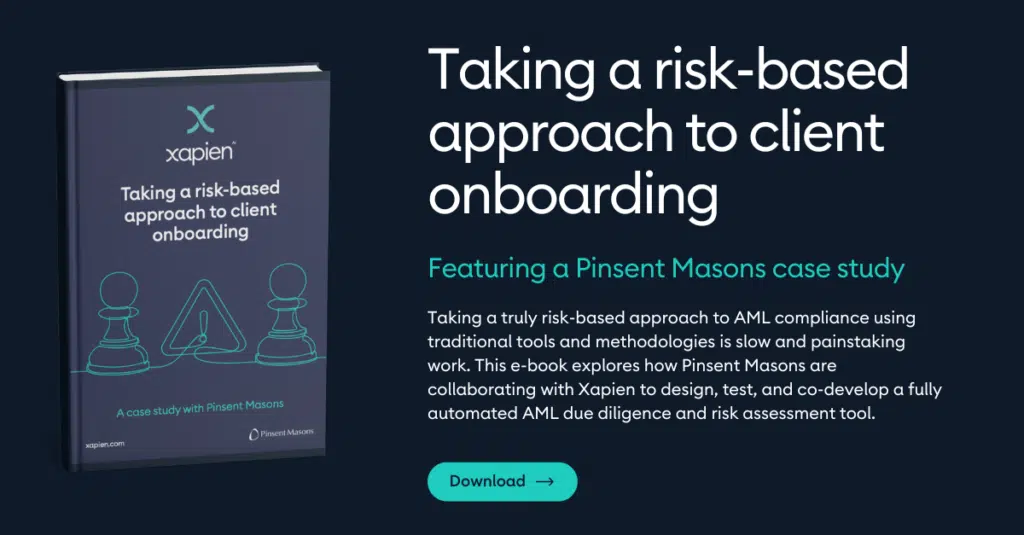
Client intake:
How the right client intake software improves clearance times

Compliance teams we talk to often feel overwhelmed and under-resourced when it comes to AML compliance. And it’s not surprising—many firms still use manual, outdated processes that slow client onboarding and have a disproportionate focus on low and medium-risk clients. Firms need better client intake software to balance AML compliance effectively, meeting both client needs and the growing complexity of international regulatory requirements.
The challenges of manual client intake processes
Many firms centralise client onboarding using standardised AML policies. In this process, client-facing staff manually gather the required information and then compliance teams review it. While effective, this “global gold standard” approach often requires higher due diligence standards than necessary.
A nuanced system which tailors due diligence to client risk levels and local AML rules, requires specialised compliance personnel and robust auditing to mitigate regulatory risk. Conversely, the global gold standard is simpler and safer to manage centrally but increases delays and creates more work for client-facing teams.
Without a risk-based triage system, compliance teams overfocus on low-risk clients, creating process inefficiencies and delaying billable work. This delays billable work and impacts client relationships and the firm’s bottom line, as fee-earning time is taken up dealing with AML queries.
What is client intake software?
Client intake software is a specialised technology that simplifies onboarding new clients by automating administrative tasks, collecting essential information, and ensuring regulatory compliance. This broad category includes ID verification software, risk-based questionnaires, virtual data rooms, document summarisation tools, monitoring tools for financial transactions, and risk-scoring software.
Advances in AI technology have created a new wave of client intake software for firms to choose from. Each option automates and streamlines a specific part of the process, but rarely covers the end-to-end client onboarding. While automation is key, it only tackles one part of the broader challenges firms face. If compliance teams are using four different tools to onboard a client, they should be looking at how to consolidate that into one or two integrated solutions.
How AI is enriching client intake software
For some law firms, the concern around AI is that it will create more work. Others worry that AI can take their work away. Neither is true. No matter the size of your law firm, AI can be game-changing for maintaining AML compliance and automating manual client intake processes. Compliance teams, even when equipped with database and search tools, simply can’t match the power and speed of AI.
Conducting full due diligence on every client can take days, frustrating firms and clients alike. This is becoming increasingly true as jurisdictions implement idiosyncratic policies. Compliance teams can delegate manual onboarding processes to client intake software using advanced AI technology, and let it do the manual due diligence, analysis and report writing. Compliance teams can then apply their judgement and expertise in line with the firm’s AML risk appetite, its AML policy and applicable AML laws and regulations. This enables analysts to swiftly clear low-risk clients and reallocate resources to the more complex task of high-risk client clearance.
Why choose Xapien for your client intake process
Xapien is a purpose-built tool for AML due diligence, transforming it from a potential blocker into a beneficial process for firms. To better tailor our platform for legal AML due diligence clearances, we partnered with global law firm, Pinsent Masons. This partnership will include the development of new features, such as consolidated risk assessment and screening reports, aiming to automate a large proportion, if not all, of the AML due diligence process. While the development and design work is done in close collaboration with experts from Pinsent Masons, the tool will be available to other law firms and AML-regulated businesses.

FAQ: Client intake software
1. What is client intake software?
Client intake software is technology designed to automate and streamline the process of onboarding new clients. It handles manual tasks such as collecting client information for KYC checks, screening client names against AML databases, conducting Customer Due Diligence using adverse media screening and summarising findings into reports.
2. What are the benefits of client intake software?
The key benefits include:
- Reduced manual information-gathering to speed up onboarding.
- Ensures law firms adhere to varying global AML standards.
- Improved clearance times for low to medium-risk clients.
- Eliminates the need to juggle multiple tools and systems.
- Technological edge enables firms to secure clients more effectively
3. How does AI enhance client intake software?
- Automating complex processes like client risk assessments.
- Performing internet-wide searches for AML due diligence.
- Using Natural Language Processing (NLP) to understand context in its search.
- Improving accuracy with disambiguation to identify the right subject.
- Summarising its findings using the latest in generative AI technology,
4. What features should I look for in client intake software?
Key features to consider include:
- Corporate information acquisition
- Sanctions and PEP screening
- Risk profiling
- Bespoke risk report
- Adverse media summarisation
- Disambiguation capabilities
5. Can client intake software replace multiple tools?
Yes, advanced tools like Xapien can consolidate functions like AML screening, adverse media screening, risk scoring and summarising findings into a due diligence report. This reduces inefficiencies and delays caused by juggling multiple tools.
6. Is client intake software secure?
Reputable platforms prioritise security with:
- Data encryption to protect sensitive information.
- Access controls such as multi-factor authentication.
- Compliance with GDPR, HIPAA, and other privacy regulations.
7. How does Xapien differ from other client intake tools?
Xapien stands out due to its:
- Advanced disambiguation technology, ensuring accurate identification of entities.
- Integration of compliance datasets alongside web-sourced risk information.
- Anti-hallucination technology, verifying the accuracy of a report’s content.
8. Can generative AI be trusted for client intake?
While generative AI is good at producing coherent summaries, it may lack accuracy and verification in due diligence. Tools like Xapien mitigate this by combining generative AI with structured compliance datasets and anti-hallucination safeguards, ensuring reliable results.
9. How does client intake software help with GDPR compliance?
Client intake software minimizes GDPR risks by:
- Limiting the volume of personal data processed.
- Automating data collection in a compliant manner.
- Ensuring sensitive information is securely managed and used responsibly.
10. Is client intake software scalable?
Most platforms are designed to scale with your law firm, handling increased client volumes and integrating with larger tech systems without disrupting workflows. Xapien works through a web portal right out of the box, requiring minimal training. Our customer success team will set you up and you can get started immediately.
Monthly learnings and insights to your inbox
Xapien streamlines due diligence
Xapien's AI-powered research and due diligence tool goes faster than manual research and beyond traditional database checks. Fill in the form to the right to book in a 30 minute live demonstration.